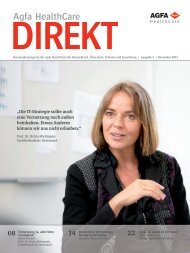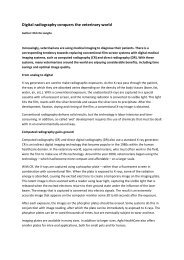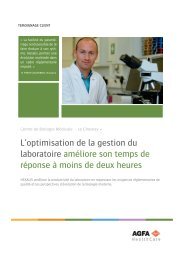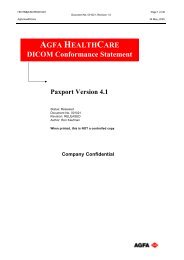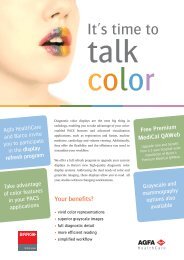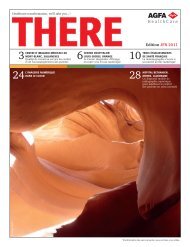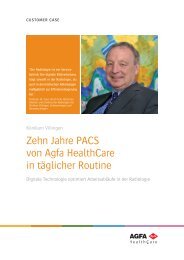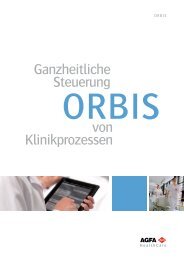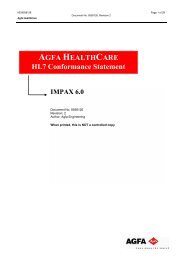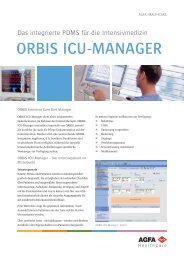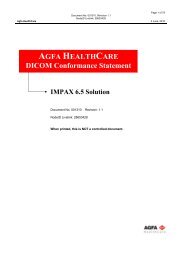Edition 4 - Agfa HealthCare
Edition 4 - Agfa HealthCare
Edition 4 - Agfa HealthCare
Create successful ePaper yourself
Turn your PDF publications into a flip-book with our unique Google optimized e-Paper software.
Dr. Frank Rademakers is a<br />
Professor of Medicine and<br />
Cardiology and Medical<br />
Director at the University<br />
Hospital of Leuven (Belgium),<br />
which he joined in 1998<br />
following an extensive career<br />
at the University of Antwerp.<br />
Apart from his responsibilities<br />
at the hospital, Dr. Rademakers<br />
teaches cardiovascular sciences<br />
at the Catholic University of<br />
Leuven. He presently chairs<br />
the Council on Cardiovascular<br />
Imaging of the ESC and<br />
heads the European Council<br />
on Cardiovascular Imaging,<br />
joining radiologists,<br />
cardiologists and nuclear<br />
physicians.<br />
Improving efficiency in cardiology<br />
WITH CARDIOLOGY PACS AND CVIS<br />
Interview with Prof. Dr. Frank Rademakers,<br />
Medical Director University Hospital Leuven<br />
If you look back at the past ten years,<br />
what has changed in cardiology<br />
“I think a primary change we have<br />
seen over the past ten years is a move<br />
towards new imaging technologies and<br />
clinical applications, which enabled<br />
cardiologists to significantly improve<br />
their overall diagnostic ability. We are<br />
able today to evaluate the heart with<br />
the use of advanced Echo, Computed<br />
Tomography (CT), Positron Emission<br />
Tomography (PET), Magnetic Resonance<br />
Imaging (MRI), and so on. Stand-still<br />
heart images were replaced by cine-loops<br />
and the limitations we faced with Echo<br />
have been corrected by the arrival of, for<br />
example, MRI. When I started my career,<br />
an electrocardiogram (ECG), a chest<br />
x-ray and an M-mode echocardiogram<br />
were the only real viable techniques<br />
driving non-invasive heart analysis.<br />
Although they were effective and remain<br />
key diagnostic tools today, they were also<br />
limited when used on their own, as they<br />
failed to deliver relevant quantitative<br />
information.”<br />
“This brings me to the second and<br />
most important change we have seen<br />
in the past ten years: the introduction<br />
of new technologies that allow us<br />
to quantify results. Primarily driven<br />
by the introduction of 2D Echo and<br />
new imaging technologies such as CT,<br />
PET, MRI, and so on, cardiology has<br />
become much less about assumption,<br />
based on qualitative images, and much<br />
more about facts, based on numbers.<br />
Patient follow-up is based on objective<br />
quantitative data rather than on<br />
qualitative and subjective evaluations.<br />
This has made diagnostic imaging a<br />
core element in our field. This in turn<br />
opened up a new field in cardiology,<br />
as with figures in hand, we are in a<br />
position to quantify studies and take our<br />
field into a new dimension – advanced<br />
research, evidence-based medicine and<br />
cardiovascular guidelines.”<br />
You could say that PACS (Picture<br />
Archiving and Communications<br />
System) and CVIS (Cardiovascular<br />
Information System) are a relatively<br />
new phenomenon in Cardiology.<br />
What is your vision on their use and<br />
functionality<br />
“Both PACS and CVIS have brought<br />
clear benefits to improving overall<br />
efficiencies in cardiology. Cardiologists<br />
often require in their diagnostic or<br />
therapeutic reasoning multiple sets of<br />
images that can contain anything from a<br />
few to several hundred images, and, at<br />
times, from different modalities. Being<br />
able to call up these images and apply<br />
advanced clinical applications to support<br />
the quantification of results is a major<br />
boost in our ability to diagnose patients<br />
more effectively and more efficiently.”<br />
“The consolidated availability of<br />
digital data and images in cardiology<br />
has significant implications on patient<br />
management in multiple hospital<br />
20 THERE



